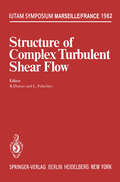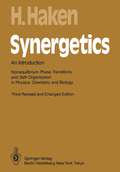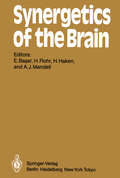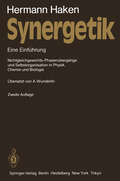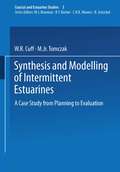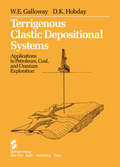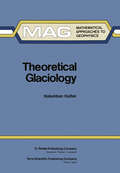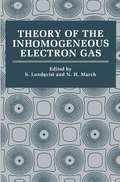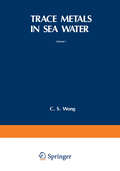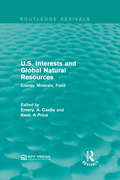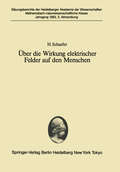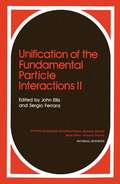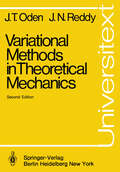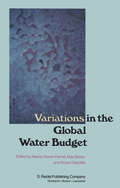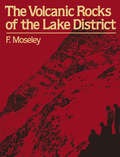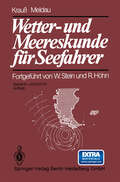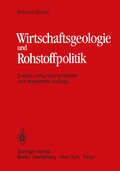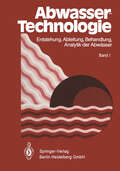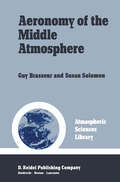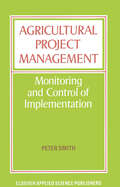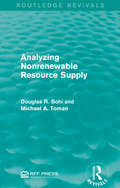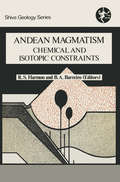- Table View
- List View
Structure of Complex Turbulent Shear Flow: Symposium, Marseille, France August 31 – September 3, 1982 (IUTAM Symposia)
by R. Dumas L. FulachierThe Symposium on structure of Complex turbulent shear flows was proposed by the "Comite National Fran
Synergetics: An Introduction (Springer Series in Synergetics #1)
by Hermann HakenOver the past years the field of synergetics has been mushrooming. An ever increasing number of scientific papers are published on the subject, and numerous conferences all over the world are devoted to it. Depending on the particular aspects of synergetics being treated, these conferences can have such varied titles as "Nonequilibrium Nonlinear Statistical Physics," "Self-Organization," "Chaos and Order," and others. Many professors and students have expressed the view that the present book provides a good introduction to this new field. This is also reflected by the fact that it has been translated into Russian, Japanese, Chinese, German, and other languages, and that the second edition has also sold out. I am taking the third edition as an opportunity to cover some important recent developments and to make the book still more readable. First, I have largely revised the section on self-organization in continuously extended media and entirely rewritten the section on the Benard instability. Sec ond, because the methods of synergetics are penetrating such fields as eco nomics, I have included an economic model on the transition from full employ ment to underemployment in which I use the concept of nonequilibrium phase transitions developed elsewhere in the book. Third, because a great many papers are currently devoted to the fascinating problem of chaotic motion, I have added a section on discrete maps. These maps are widely used in such problems, and can reveal period-doubling bifurcations, intermittency, and chaos.
Synergetics of the Brain: Proceedings of the International Symposium on Synergetics at Schloß Elmau, Bavaria, May 2 – 7, 1983 (Springer Series in Synergetics #23)
by E. Basar H. Flohr Hermann Haken A. J. MandellSynergetics may be considered as an interdisciplinary effort dealing with the gene ral problem of how science can cope with complex systems. The preceding symposia on synergetics were devoted to systems of physics, chemistry and partly also biolo gy and sociology. It was possible to develop adequate concepts to describe and even to calculate evolving macroscopic spatial, temporal, and functional structures which emerge through self-organization of the individual parts of the systems under con sideration. This book contains the invited papers presented at the Symposium on the Synerge tics of the brain, Schloss Elmau, Bavaria, May 2 to 7, 1983. The inclusion of this topic in the synergetics enterprise represents a big step towards a treatment of complex systems. Most probably the human brain is the most complex system we know of. As the organizers believe, this symposium provides the reader with a good cross section of experimental results and theoretical approaches to cope with the complex problems of structure and function of the brain. It was generally felt that such a joint meeting between experimentalists and theoreticians is of great importance for future development of this field. Modern experimental methods, e. g. multielectrode derivations allow or will allow us, in short, to collect huge amounts of data. Simi larly high-speed computers will flood us with an enormous number of outputs once the basic model equations have been chosen.
Synergetik: Eine Einführung Nichtgleichgewichts-Phasenübergänge und Selbstorganisation in Physik, Chemie und Biologie
by Hermann HakenSynthesis and Modelling of Intermittent Estuaries: A Case Study from Planning to Evaluation (Coastal and Estuarine Studies #3)
by W. R. Cuff M. Jr. TomczakThis book reports on the findings of, and swnmarizes the conclusions from, the Port Hacking Estuary Project, a model-guided, multidisciplinary study of an estuarine ecosystem. The Project began in 1973, at a time when it was thought that environmental problems could be solved readily by assembling a multidisciplinary team of research scientists and having them co-ordinate their research around the construction of an ecosystem model. But a decade has passed and time has not been easy on this approach. The anticipated predictive dynamic models have not been produced and bitter argument has often marred the course of such studies. Yet the need to anticipate the flow of various chemical species (carbon, oxygen, nitrogen, phosphorus, toxicants) through the environment remains: the evidence is everywhere, from fertilization of urban lakes to acid rain. The magnitude of the problem ensures that funds will continue to be made available - although with short-term variations as perceptions swing. It is thus clear that although the difficulties are great, so is the need. It is from this background that we present this book. The Port Hacking Estuary Project involved some 15 - 20 research scientists over a period of 5 years. The goal was to research the flow of carbon into, within, and out of a small unpolluted estuary chosen for convenience rather than for its social significance. The idea was to use the information obtained from these studies to build a predictive dynamic model.
Terrigenous Clastic Depositional Systems: Applications to Petroleum, Coal, and Uranium Exploration
by W. E. Galloway D. K. HobdayThe reserves, or extractable fraction, of the fuel-mineral endowment are sufficient to supply the bulk of the world's energy requirements for the immediately forseeable future-well into the next century according to even the most pessimistic predictions. But increasingly sophisticated exploration concepts and technology must be employed to maintain and, if possible, add to the reserve base. Most of the world's fuel-mineral resources are in sedimentary rocks. Any procedure or concept that helps describe, under stand, and predict the external geometry and internal attributes of major sedimentary units can therefore contribute to discovery and recovery of coal, uranium, and petroleum. While conceding the desirability of renewable and nonpolluting energy supply from gravitational, wind, or solar sources, the widespread deployment of these systems lies far in the future-thus the continued commercial emphasis on conventional nonrenewable fuel mineral resources, even though their relative significance will fluctuate with time. For example, a decade ago the progilostications for uranium were uniformly optimistic. But in the early 1980s the uranium picture is quite sombre, although unlikely to remain permanently depressed. Whether uranium soars to the heights of early expectations remains to be seen. Problems of waste disposal and public acceptance persist. Fusion reactors may ultimately eliminate the need for uranium in power generation, but for the next few decades there will be continued demand for uranium to fuel existing power plants and those that come on stream. This book is, to some extent, a hybrid.
Theoretical Glaciology: Material Science of Ice and the Mechanics of Glaciers and Ice Sheets (Mathematical Approaches to Geophysics #1)
by K. HutterThe purpose and scope of this book on theoretical glaciology is outlined in the Introduction. Its aim is to study the theoretical aspects of'ice mechanics' and the 'dynamics of ice masses in a geophysical environment. For the mature reader, the book can serve as an introduction to glaciology. How ever, this is not what I would regard as advisible. Glaciology is an inter disciplinary science in which many special scientific disciplines play their part, from descriptive geography to fairly abstract mathematics. Advance ment will evolve from a merger of two or more branches of scientific specialization. In the last 20 years, several researchers in different fields of glaciology have written books emphasizing the aspects of their specialities and I have listed some which are known to me at the end of the Introduction. When glancing through these books, one recognizes that the mathematical aspects of glaciology are generally glossed over and, to date, there seems to be nothing available which concentrates on these. Therefore, I have written this book in an effort to close the gap and no apologies are offered for the mathematical emphasis. Rather, I believe that this neglect has, to a certain extent, aggra vated progress in the modelling of glaciology problems.
Theory of the Inhomogeneous Electron Gas (Physics of Solids and Liquids)
by Stig Lundqvist Norman H. MarchThe theory of the inhomogeneous electron gas had its origin in the Thomas Fermi statistical theory, which is discussed in the first chapter of this book. This already leads to significant physical results for the binding energies of atomic ions, though because it leaves out shell structure the results of such a theory cannot reflect the richness of the Periodic Table. Therefore, for a long time, the earlier method proposed by Hartree, in which each electron is assigned its own personal wave function and energy, dominated atomic theory. The extension of the Hartree theory by Fock, to include exchange, had its parallel in the density description when Dirac showed how to incorporate exchange in the Thomas-Fermi theory. Considerably later, in 1951, Slater, in an important paper, showed how a result similar to but not identical with that of Dirac followed as a simplification of the Hartree-Fock method. It was Gombas and other workers who recognized that one could also incorporate electron correlation consistently into the Thomas-Fermi-Dirac theory by using uniform electron gas relations locally, and progress had been made along all these avenues by the 1950s.
Trace Metals in Sea Water (Nato Conference Series #9)
by C. WongIn recent years, rapid scientific advances have been shattering classical concepts of oceanic trace metals concentrations. Most of the data gathered before the mid-1970s have had to be discarded. Possible associations of organic and inorganic ligands with the metals were throwing views of metal speciation into great uncertainty. Biological effects of metals need to be re-examined after recent revelations of unsuspected metal contaminations in methodology. The investigations appear chaotic, yet exciting. It implies that a new order is going to replace the past. Now, an opportunity opens its door to a brave new world for the young generation of scientists to put metal chemistries in the oceans into perspectiveo This N. AoToO. International Conference on "Trace Metals in Sea Water" hoped to catalyze this exciting process of unifying various aspects of trace metals in sea water in future years o The Conference, in the form of an Advanced Research Institute supported by the Scientific Affairs Division of NoAoT. O. supple mented by further assistance of the UoS. Office of Naval "Research, was held at the "Ettore Majorana" Center for Scientific Culture in the medieval town of Erice on the island of Sicily, Italy from March 30 to April 3, 1981. It was the first organized gathering of international scientists in this specialized field. Seventy scientists with various expertise in different aspects of the subject were present: including those from NoAoT. Oo countries (Canada, France, F. R. Germany, Greece, Iceland, Italy, U. K.
U.S. Interests and Global Natural Resources: Energy, Minerals, Food (Routledge Revivals)
by Emery N. Castle Kent A. PriceOriginally published in 1983, U.S. Interests and Global Natural Resources explores the links between foreign policy and the global distribution of natural resources paying particular attention to the U.S. This collection of essays delves into the importance of factors such as differing economic development and political hostility could have on the provision of resources into the U.S and advises that nations identify their countries needs and establish policies to safeguard them. This title will be of interest to students of Environmental Studies and Policy makers.
U.S. Interests and Global Natural Resources: Energy, Minerals, Food (Routledge Revivals)
by Emery N. Castle Kent A. PriceOriginally published in 1983, U.S. Interests and Global Natural Resources explores the links between foreign policy and the global distribution of natural resources paying particular attention to the U.S. This collection of essays delves into the importance of factors such as differing economic development and political hostility could have on the provision of resources into the U.S and advises that nations identify their countries needs and establish policies to safeguard them. This title will be of interest to students of Environmental Studies and Policy makers.
Über die Wirkung elektrischer Felder auf den Menschen: Vorgetragen in der Sitzung vom 26. Juni 1982 (Sitzungsberichte der Heidelberger Akademie der Wissenschaften #1983 / 3)
by H. SchaeferUnification of the Fundamental Particle Interactions II (Ettore Majorana International Science Series #15)
by John EllisWork on the unification of the fundamental particle interac tions has continued vigorously since the first Europhysics study Conference on this subject. At that time we emphasized the exis tence of two main approaches, one based on supersymmetry and pos sibly its local version, supergravity, and the other approach based on grand unified gauge theories. Discussion of the possible tests of these theoretical speculations included experiments on baryon decay and neutrino oscillations. In view of the uncertainties surrounding the observability of such phenomena, the early Universe was welcomed as a possible Laboratory for testing new theoretical ideas. At that time, we expressed the hope that the different gauge and super symmetry approaches would cross-fertilize each other" and it is appropriate to ask now how much of that hope has been realized. We believe there has recently been considerable theoretical rapprochement, which is amply reflected in these Proceedings. On the one hand it has been realized that many of the technical pro blems in grand unified gauge theories, such as arranging the hierarchy of different mass scales, may be alleviated using simple global supersymmetry. On the other hand there has been growing interest in the possibility that extended supergravity theories may furnish a suitable framework for the unification of all the fundamental particle interactions. Many physicists in fact now question actively whether the known "fundamental" particles are in deed elementary, or whether they are composite.
Variational Methods in Theoretical Mechanics (Universitext)
by J.T. Oden J.N. ReddyThis is a textbook written for use in a graduate-level course for students of mechanics and engineering science. It is designed to cover the essential features of modern variational methods and to demonstrate how a number of basic mathematical concepts can be used to produce a unified theory of variational mechanics. As prerequisite to using this text, we assume that the student is equipped with an introductory course in functional analysis at a level roughly equal to that covered, for example, in Kolmogorov and Fomin (Functional Analysis, Vol. I, Graylock, Rochester, 1957) and possibly a graduate-level course in continuum mechanics. Numerous references to supplementary material are listed throughout the book. We are indebted to Professor Jim Douglas of the University of Chicago, who read an earlier version of the manuscript and whose detailed suggestions were extremely helpful in preparing the final draft. We also gratefully acknowedge that much of our own research work on va ri at i ona 1 theory was supported by the U. S. Ai r Force Offi ce of Scientific Research. We are indebted to Mr. Ming-Goei Sheu for help in proofreading. Finally, we wish to express thanks to Mrs. Marilyn Gude for her excellent and painstaking job of typing the manuscript. This revised edition contains only minor revisions of the first. Some misprints and errors have been corrected, and some sections were deleted, which were felt to be out of date.
Variations in the Global Water Budget
by F. A. Street-Perrott Max Beran R. RatcliffR.E. Newell President, International Commission on Climate International Association of Meteorology and Atmospheric Physics Water is the active ingredient in the global climatic system, its physical properties ensuring that it plays a major role. Its high thermal capacity provides a mechanism for moderating mid latitude winter temperatures; solar energy is absorbed by the surface layers of the middle latitude oceans in summer and is released to the atmosphere in winter as the ocean cools. The variation of saturation vapour pressure with temperature is the factor which causes oceanic surface temperatures at low latitudes to be limited by evaporation to values near 29°C, thereby limiting tropical marine air temperatures to about the same value. The substantial amount of energy involved in phase changes - the latent heat - governs the passage of solar energy to the atmo sphere; visible solar radiation is absorbed at the Earth's surface, energy is supplied to evaporate water and the latent heat is released to the atmosphere when and where condensation occurs, which is often a considerable distance from the source of the moisture. The infrared radiative characteristics of water vapour, namely the broad vibration-rotation bands typical of a triatomic molecule, permit it to act as the principal agent of energy loss from the atmosphere, throu?,h infrared radiation to space.
Victims of the Environment: Loss from Natural Hazards in the United States, 1970–1980
by James D. Wright Peter H. Rossi Joseph A. Pereira Eleanor Weber-BurdinThe research reported in this volume was designed to provide estimates of the extent of damages and injuries from certain natu ral hazards inflicted on households in the United States. In addi tion, it reports on sources of aid proffered to households and the extent to which there are differences among households in the receipt of help. This volume represents the latest installment in a series of monographs stemming from the Social and Demographic Re search Institute's (SADRI) program of research on the effects of natural hazard events in the United States. The first volume in our series (Wright, Rossi, Wright, & Weber-Burdin, 1979) reported on the long-range effects of natural hazards on the population and housing stocks of neighborhoods and communities. The second volume (Rossi et aI. , 1982) assessed the support for hazard mitiga tion policies existing among local and state political elites in a sample of states and local communities in the United States. The main findings of these two monographs can be summarized as follows. First, long-range effects (up to 10 years postevent) of nat ural hazard events are minimal: Local communities and neighbor hoods that have been impacted by floods, tornadoes, or hurricanes appear to be no different in their population and housing growth patterns over the period 1960 to 1970 than comparable commu nities that went unscathed. Apparently, household and communi ty resources plus outside aid were sufficient ordinarily to restore impacted areas to normal growth patterns.
Wetter- und Meereskunde für Seefahrer
by Joseph Krauß Heinrich MeldauDie erste Auflage dieses Buches erschien im Jahre 1917 unter dem Titel "Krauß, Grundzüge der maritimen Meteorologie und Ozeanographie". Im Jahre 1931 erschien die zweite Auflage unter Mitarbeit von Professor Dr. Meldau, Seefahrtschule Bremen. An Stelle des 1937 verstorbenen Professor Dr. Meldau trat mit der dritten Auflage Dr. Walter Stein, Seefahrtschule Bremen, als Mitarbeiter ein. Die dritte Auflage erschien im Jahre 1952, eine vierte im Jahre 1958. Die fünfte Auflage wurde 1963 von Dr. Stein allein herausgegeben, nachdem Direktor Krauß im Jahre 1961 verstorben war. Mit Direktor Krauß verlor die deutsche Schiffahrt einen ihrer besten Lehrer und Erzieher. Es ist den Herausgebern ein tief verpflichtender Auftrag, dieses Buch, das dem Verstorbenen immer besonders am Herzen lag, in seinem Sinne und nach seinen Plänen weiterzuentwickeln. Dieses Buch, das seit der zweiten Auflage den Titel "Wetter-und Meeres kunde für Seefahrer" trägt, will in erster Linie eine Hilfe für den Unterricht in der Wetter-und Meereskunde an den Seefahrtschulen sein. Es kann aber auch dem Sportsegler und dem Seefischer Verständnis für die Vorgänge in der Luft und im Wasser vermitteln. Der für die Navigation verantwortliche Nautiker muß sich natürlich über den allgemeinen Rahmen dieses Buches weit hinausgehende Kenntnisse von den meteorologischen und hydrographischen Verhältnissen seines Fahrtgebietes erwerben. Dafür stehen ihm die einschlägigen Veröffentlichungen des Seewetteramtes und des Deutschen Hydrographischen Institutes in Hamburg zur Verfügung, deren genaues Studium für ihn unerläßlich ist. Für die fünfte Auflage wurde das Buch im wesentlichen unverändert gelassen.
Wirtschaftsgeologie und Rohstoffpolitik: Untersuchung, Erschließung, Bewertung, Verteilung und Nutzung mineralischer Rohstoffe
by W. GochtAbwassertechnologie: Entstehung, Ableitung, Behandlung, Analytik der Abwässer
by W. Czysz A. Denne H. Rump W. Schneider E. Staudte W. Supperl E. Blitz B. Böhnke P. Doetsch P. Dreschmann K. Pöppinghaus K. Siekmann S. ThomasDieses Handbuch deckt die gesamte Problematik der Abwassertechnologie ab: Abwasseranfall aus dem häuslichen und industriellen Bereich, direkte und indirekte Abwasserableitung, Abwasserbehandlung sowie der Gewässerschutz werden gemeinsam behandelt. Die umfassende Darstellung berücksichtigt nicht nur die Aspekte der Industrieländer, sondern vor allem die Probleme der Schwellen- und Entwicklungsländer. Die Auswahl der Information ist stark praxisorientiert. Das Buch liefert damit die Voraussetzung für eine fachlich abgestimmte Entwicklungspolitik auf dem Gebiet der Abwasserentsorgung und bietet Beratern, Ingenieurbüros und beteiligten Firmen eine Basis für die Diskussion, Planung und Realisierung konkreter Projekte. Es ist beabsichtigt, das Buch später auch in französischer und englischer Sprache zu publizieren.
Aeronomy of the Middle Atmosphere: Chemistry and Physics of the Stratosphere and Mesosphere (Atmospheric Sciences Library)
by Guy BrasseurThe reader may be surprised to learn that the word "aeronomy" is not found in many of the standard dictionaries of the English language (for exam ple. Webster's International dictionary). Yet the term would appear to exist, as evidenced by the affiliations of the two authors of this volume (Institut d'Aeronomie, Brussels, Belgium; Aeronomy Laboratory, National Oceanic and Atmospheric Administration, Boulder, CO, USA). Perhaps part of this obscu rity arises because aeronomy is a relatively new and evolving field of endeavor, with a history dating back no farther than about 1940. The Chambers dic tionary of science and technology provides the following definition: "aeronomy (Meteor. ). The branch of science dealing with the atmosphere of the Earth and the other planets with reference to their chemical com position, physical properties, relative motion,
Agricultural Project Management: Monitoring and Control of Implementation
by Peter SmithI first became interested in the methods of planning the sequence and timing of jobs on large-scale development projects, as a field officer involved in planning and implementing mechanised farming schemes in Uganda in the mid-sixties. This interest was reinforced by experience of agro-industrial projects in both Nigeria and Iran, when it became obvious that the lax traditional methods of both planning and controll ing the implementation of agricultural and other rural development projects were very ineffective compared with those already in use in other disciplines. An extended spell as Resident Adviser on a World Bank project to strengthen planning and project management services in the agricultural sector in Sind Province, Pakistan, stimulated this interest further, and gave opportunities to develop the use of improved methods on some very complex schemes. This book summarises the experience gained in adapting critical path methods, well established in other fields, to Third World development projects, with their peculiar problems. It would not have been possible to reach this point without the help and stimulation of discussions with a large number of colleagues, includ ing John Joyce (then of Hunting Technical Services), Hatsuya Azumi (World Bank), and-particularly-Zaffar Sohrwardy and Akhtar Ali of Aarkays Associates in Karachi, during our work together. My thanks are also due to Yasin Mohammed, who typed most of the original draft; Anwar Mohammed and Irene Mills for final typing; and to my wife, Jill, for drawing the original figures.
Analyzing Nonrenewable Resource Supply (Routledge Revivals)
by Douglas R. Bohi Michael A. TomanOriginally published in 1984, Douglas A. Bohi and Michael A. Toman have produced a convenient reference source about disparate elements in the theory of nonrenewable resource supply and about general issues that arise when applying dynamic economic analysis. The authors emphasise the inherently dynamic nature of resource supply decisions, the effects of resource depletion on costs and behaviour, and the influence of uncertainty about costs, prices, and reserves. This title will be useful to students interested in environmental studies and economics, practitioners, and others who need to know more about complex interactions of economic forces and the resource base.
Analyzing Nonrenewable Resource Supply (Routledge Revivals)
by Douglas R. Bohi Michael A. TomanOriginally published in 1984, Douglas A. Bohi and Michael A. Toman have produced a convenient reference source about disparate elements in the theory of nonrenewable resource supply and about general issues that arise when applying dynamic economic analysis. The authors emphasise the inherently dynamic nature of resource supply decisions, the effects of resource depletion on costs and behaviour, and the influence of uncertainty about costs, prices, and reserves. This title will be useful to students interested in environmental studies and economics, practitioners, and others who need to know more about complex interactions of economic forces and the resource base.
Andean Magmatism: Chemical and Isotopic Constraints
by HARMON/BARREIRODestructive plate margin magmagenesis is one of the most intensely studied and widely debated topics in the earth sciences at present. Calc-alkaline volcanic and plutonic rocks in orogenic settings exhibit such a diversity of composition and character that the subducted oceanic lithosphere, the overlying 'enriched' lithospheric mantle and the lower continental crust all have been advocated recently as the primary source region for island-arc and continental-margin basaltic to andesitic magmas. The role of the upper continental crust is also a matter of continuing controversy. It is clear that crustal contamination is a common, but not universal, feature of destructive plate margin magmatism. Whether this contamination is introduced at source by subduction-related processes or occurs during magma transit by bulk anatexis and magma mixing, selective contamination or coupled fractional crystallization-assimilation mechanisms is central to most current discussions of andesite petrogenesis. This book presents a series of papers which directly address these and other important geological and geochemical problems within the context of the Mesozoic-Cenozoic calc-alkaline magmatism characteristic of the Andean Cordillera of western South America. Although it is aimed primarily at postgraduate students and researchers familiar with the Andes, it is also a useful general reference for workers in other fields who wish to gain an insight into current thoughts, ideas and speculations on 'andesitic' magmatism at destructive plate margins.
